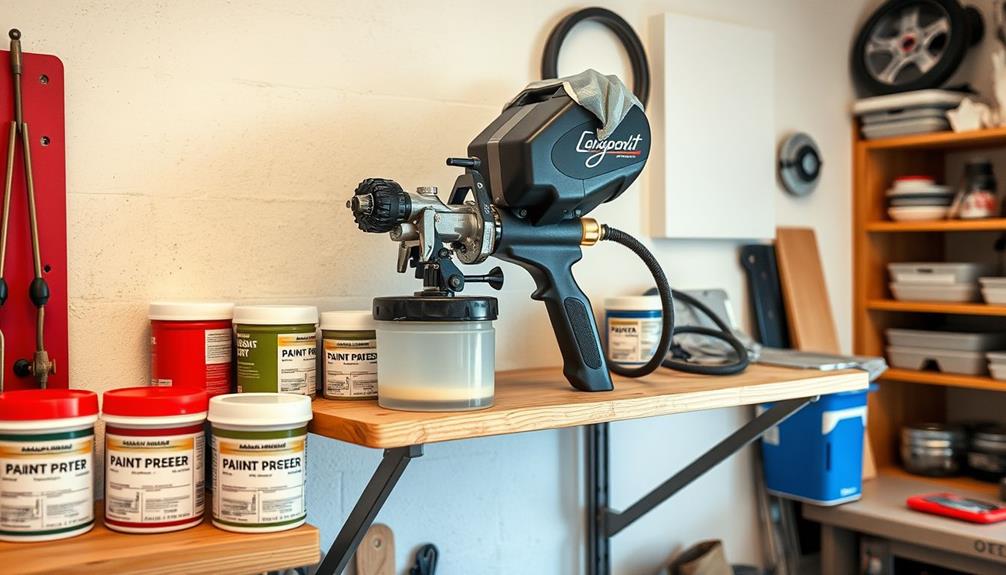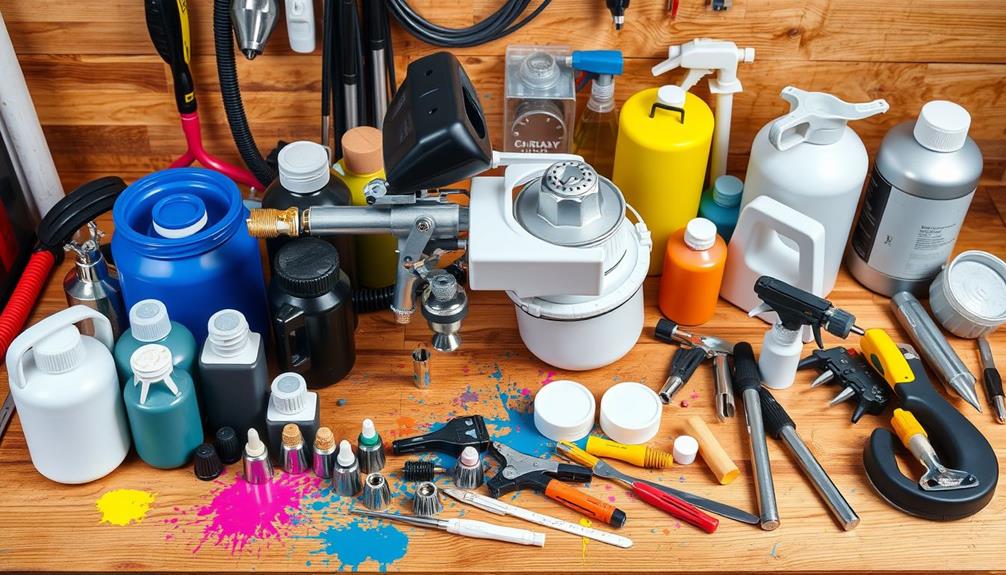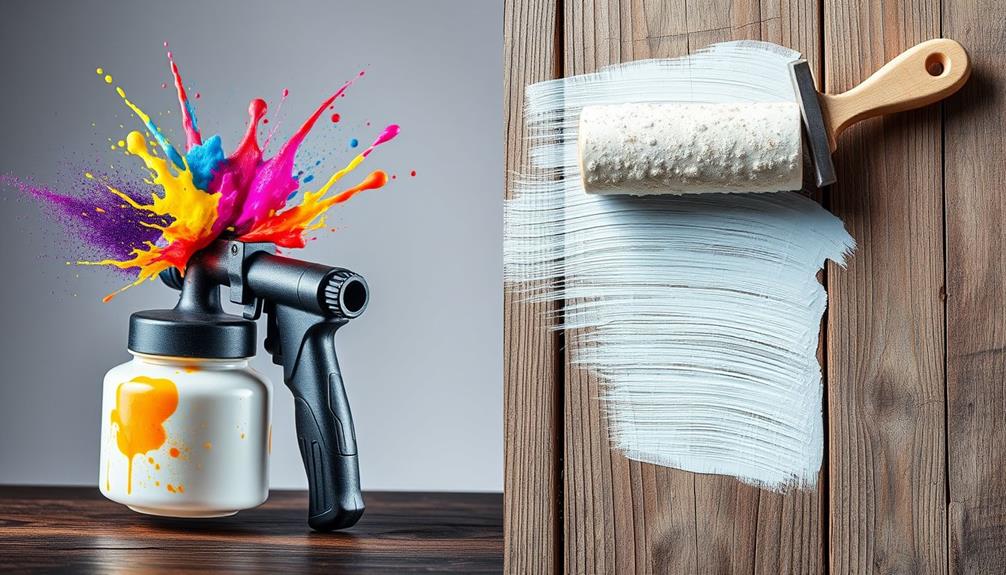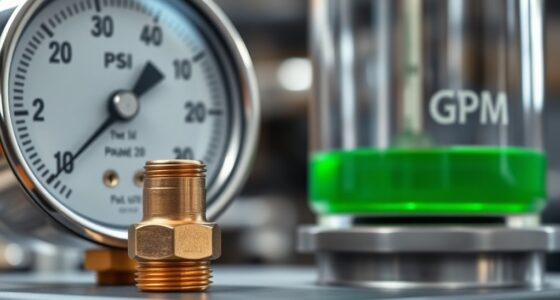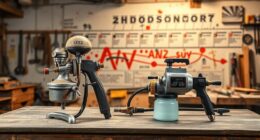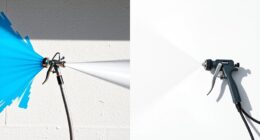To properly store your airless paint sprayer, start by thoroughly cleaning it to prevent clogs. Release any pressure and flush the system with clean water for short-term storage or use mineral spirits for longer durations. Apply a suitable pump protectant like Graco Pump Armor to preserve seals. Store the sprayer indoors in a stable temperature to avoid freeze damage. Verify suction and drain tubes stay submerged to prevent paint drying. Regular maintenance checks are key to prolonging its lifespan. Want to know more tips to keep your sprayer in top condition? There's plenty more to explore!
Key Takeaways
- Always perform a thorough cleaning and flushing of the sprayer before storage to prevent clogs and corrosion.
- Use recommended pump protectants like Graco Pump Armor or a mixture of mineral spirits and engine oil for long-term protection.
- Store the sprayer indoors in a temperature-controlled environment to avoid freezing damage and maintain optimal performance.
- Release pressure from the sprayer by pulling the gun trigger before storage to ensure safety and prevent damage.
- Conduct regular maintenance checks during storage to extend the lifespan and readiness of the airless paint sprayer.
Importance of Proper Storage
Proper storage of your airless paint sprayer is vital for keeping it in top shape. When you take the time to properly clean and maintain your sprayer, you greatly extend its lifespan and reduce costly repairs.
Inadequate storage can lead to malfunctions, especially in freezing temperatures, where water-based paints can expand and cause damage. Additionally, regular maintenance and cleaning practices, such as using appropriate cleaning solutions for different paint types, are important for peak performance and longevity.
Always remember to follow thorough maintenance protocols, even if you only use your sprayer occasionally. This includes making certain that all storage liquid is removed and that the device is clean.
If you neglect proper cleaning and storage, you risk exposing your sprayer to environmental factors like extreme temperatures and moisture, which can lead to corrosion and deterioration.
Storing your airless paint sprayer indoors is a smart move; it protects the equipment from harsh conditions that could compromise its functionality.
By committing to proper storage practices, you not only safeguard your investment but also guarantee that your sprayer will be ready for action when you need it.
Don't forget that neglecting these procedures might even void your warranty, so it's important to treat your airless paint sprayer with care.
Recommended Pump Protectants

Choosing the right pump protectant can make a considerable difference in the performance and lifespan of your airless paint sprayer. One of the top recommendations is Graco Pump Armor, well-known for preserving the pump and seals during storage.
Additionally, understanding the importance of key factors in service selection can help you maintain your equipment better and guarantee you have the right tools for the job. When you use Graco Pump Armor, you confirm that your sprayer remains in prime condition, especially during long-term storage.
If you're looking for alternatives, Titan Liquid Shield is another option, but keep in mind it's not freeze-proof, which could be a concern if you live in a colder climate.
For a more versatile choice, you can consider using mineral spirits either on their own or mixed with engine oil. This combination provides solid protection during long-term storage, helping to keep your sprayer functional and ready for use when you need it.
Additionally, there are non-flammable pump protectants available, enhancing safety during your storage procedures.
The effectiveness of your chosen pump protectant will greatly impact your sprayer's performance and longevity, so be sure to select wisely to protect against potential damage from freezing conditions.
Short-Term Storage Techniques

When you need to store your airless paint sprayer for a short period, there are some key techniques to keep in mind.
First, always release the pressure by pulling the gun trigger and guarantee the suction and drain tubes stay submerged in the paint can.
Additionally, consider that improper storage can lead to clogs, much like flushing non-flushable items can cause plumbing issues; clogging remedies can be useful to know.
Also, remember that environmental factors like heat and humidity can impact the effectiveness of your temporary storage methods.
Recommended Temporary Methods
For short-term storage of your airless paint sprayer, there are several effective methods you can use to keep it in ideal condition. First, if you're pausing work for an hour to three days, leave the suction and drain tubes submerged in the paint can. This prevents the sprayer from drying out. Make sure to cover the paint can and hoses tightly with plastic wrap to minimize exposure to air and moisture.
Additionally, always release pressure from the sprayer by pulling the gun trigger before storage to avoid accidents and damage. If you're not concerned about freezing temperatures, consider submerging the spray gun in water to keep it wet and functional during temporary storage.
Here's a quick reference table for your temporary storage options:
| Method | Description |
|---|---|
| Submerged Tubes | Keep suction/drain tubes submerged in paint can. |
| Plastic Wrap | Cover paint can and hoses tightly with plastic wrap. |
| Release Pressure | Pull gun trigger before storage. |
| Submerged Spray Gun | Submerge spray gun in water, avoid freezing conditions. |
Using these methods will help maintain your sprayer's performance!
Pressure Release Steps
To guarantee safety and prevent accidental discharge, it's crucial to release the pressure in your airless paint sprayer before short-term storage. Following these pressure release steps will help you properly prepare your sprayer for the next use:
- Pull the Gun Trigger: Begin by pulling the trigger on your spray gun to relieve any trapped pressure within the system. This is similar to how air purifiers improve indoor air quality by removing unwanted particles, ensuring your equipment is safely prepared for storage.
- Submerge Tubes: Leave the suction and drain tubes submerged in the paint can. This keeps the system primed and ready for quick use.
- Cover the Paint Can: Protect the system from drying out by tightly covering the paint can and hoses with plastic wrap. This minimizes exposure to air and contaminants.
- Avoid Freezing Conditions: If you're submerging the spray gun in water to prevent paint from drying in the nozzle, make sure you're not doing this in freezing temperatures.
Always make certain that any pressure is completely released and the Prime Valve is opened before any storage procedure.
Following these safety precautions will help maintain your paint sprayer and make sure it's ready for your next project.
Environmental Considerations
Considering the impact of environmental factors on short-term storage techniques is essential for maintaining your airless paint sprayer's performance. When storing paint sprayers for a short duration—between one hour and three days—take proactive steps to prevent clogs and drying paint.
Keeping the suction and drain tubes submerged in the paint can is critical, as this simple action helps avoid the paint from drying out and clogging your sprayer. Additionally, make certain that the storage environment is at a stable temperature to avoid any sudden changes that could affect the paint's consistency, similar to how well-draining soil is significant for preventing root rot in plants.
To minimize air exposure, cover the paint can and hoses tightly with plastic wrap. This prevents skin formation on the paint surface, making sure your materials remain usable.
After releasing pressure from the sprayer, submerge the gun in water to prevent paint from drying inside the nozzle. However, avoid this method in freezing temperatures, as water can freeze and damage your sprayer's internal components.
Medium and Long-Term Storage

When it comes to medium and long-term storage of your airless paint sprayer, proper cleaning is essential. Flushing the sprayer with lacquer thinner guarantees that all paint residues are removed, preventing clogs and maintaining performance.
To enhance the longevity of your sprayer, consider using the right oil for lubrication, as correct oil selection guarantees peak sprayer performance and longevity. You'll need to flush the sprayer with lacquer thinner and use appropriate protectants to keep it in top shape.
Additionally, following the right storage techniques can prevent damage and guarantee your sprayer's ready to go when you need it again.
Cleaning Procedures Before Storage
Cleaning your airless paint sprayer before storage is essential to guarantee its longevity and maximum performance. Neglecting this step could lead to clogs and damage, so follow these procedures for effective maintenance.
Additionally, confirming that your tools are well-maintained can enhance your overall painting experience, just like how using high-quality garage door openers can improve home security and convenience.
- Relieve Pressure: Always relieve the sprayer's pressure by pulling the gun trigger and opening the Prime Valve before you start cleaning. This confirms safety and prevents any accidents during the process.
- Flush with Clean Water: Begin by flushing the system with clean water to remove any paint residue. This is especially important for medium-term storage (3-6 months).
- Use Mineral Spirits and Oil: For long-term storage (6 months to 1 year), thoroughly flush the pump with mineral spirits or Pump Armor, followed by adding 30wt oil for added protection against corrosion.
- Detach and Soak Parts: Detach the airless tip, guard, and filter. Soak them in a suitable cleaning solution to confirm all paint residue is removed, then reassemble the filter housing without the filter.
Recommended Storage Techniques
After guaranteeing your airless paint sprayer is thoroughly cleaned, proper storage techniques will help maintain its performance and longevity.
For medium-term storage, which lasts about 3 to 6 months, clean the sprayer using lacquer thinner. Assure you cycle fresh mineral spirits or Pump Armor through the system to protect the pump and seals. It's also important to take into account HVAC maintenance as a way to improve overall air quality in your workspace, which can indirectly affect your painting projects.
Always relieve pressure by pulling the gun trigger and make sure the rod is in the down position when turning off the sprayer. This prevents internal damage.
When preparing for long-term storage (6 months to 1 year), use a mixture of Pump Armor or mineral spirits combined with 30-weight oil. During the protectant cycling, apply Graco Throat Seal Liquid (TSL) for added lubrication.
Don't forget to drain all water from the hoses and the gun to prevent corrosion and freezing damage. It's crucial to store the airless sprayer indoors to shield it from extreme temperatures and environmental factors that could affect its functionality.
Very Long-Term Storage Guidelines
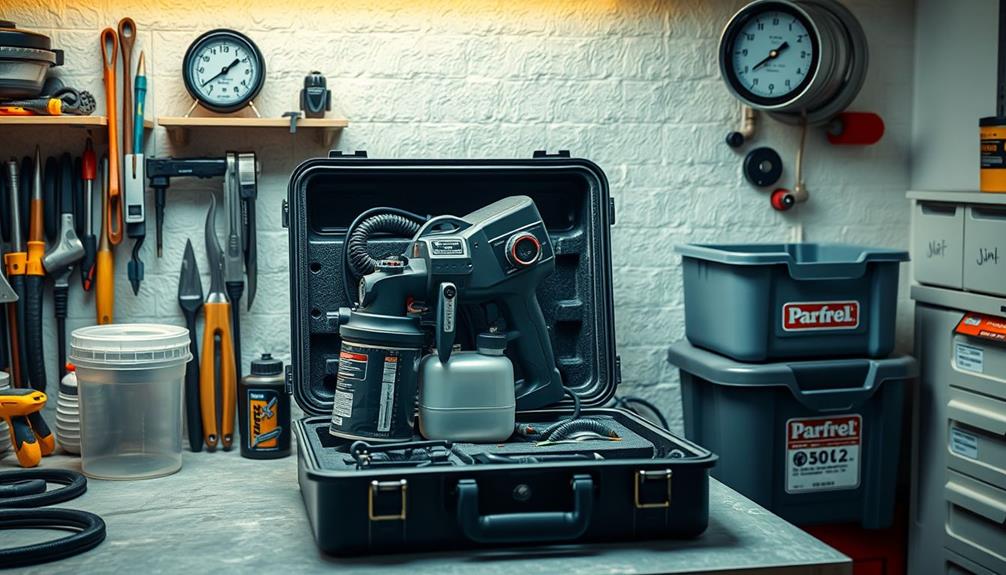
For very long-term storage of your airless paint sprayer, it's crucial to follow specific guidelines to guarantee its longevity and functionality. Proper maintenance and storage practices can greatly enhance the performance and durability of your equipment, making it ready for use when needed. Here's how you can prepare your sprayer for extended storage:
- Thoroughly Clean: Make sure all paint residue is completely removed to prevent clogs and corrosion. Use mineral spirits for effective cleaning.
- Lubricate: Mix engine oil with mineral spirits—add a few cap-fulls of oil per quart of spirits. This mixture serves as a protectant, guaranteeing smooth operation when you're ready to use it again.
- Seal Maintenance: Apply several drops of Graco Throat Seal Liquid (TSL) while cycling the protectant through the sprayer. This keeps your seals lubricated and functional.
- Store Properly: Always store your sprayer indoors, avoiding freezing temperatures that can damage components. Keep the rod in the down position after powering off to prevent pump seal damage.
Regular updates to your maintenance practices can help maintain ongoing functionality, as noted in strategies for increasing topical authority.
Common Issues and Solutions

Airless paint sprayers can face several common issues that, if not addressed properly, might hinder their performance and longevity. One major problem arises from failing to clean and flush the sprayer before storage. Dried paint residue can cause clogs, complicating future use and leading to costly repairs. Always verify thorough cleaning of filters and spray tips after each use to avoid operational problems.
Additionally, just as with proper storage practices for butter, maintaining your sprayer in an airtight container can help prevent contamination and guarantee its longevity.
Another critical issue is water left in the system, which can freeze and damage the pump assembly. To prevent this, drain all water and consider running antifreeze through the system, especially if you use your sprayer infrequently. Regular maintenance like this helps maintain functionality and prevents pump seizure.
Corrosion and breakage can also occur if improper storage practices are followed. Always use manufacturer-recommended protectants and store your sprayer without pressure.
If you need to use paint thinner for cleaning, make sure to follow up with a flush of water or antifreeze to protect your sprayer's internals. By addressing these common issues proactively, you'll guarantee your airless paint sprayer remains in peak condition for your next project.
Frequently Asked Questions
How Do You Store Graco Paint Sprayer Between Coats?
To store your Graco paint sprayer between coats, keep the suction and drain tubes in the paint can, cover everything tightly with plastic wrap, and release pressure by pulling the gun trigger for safety.
How Do You Store Spray Paint Guns?
To store spray paint guns, clean them thoroughly to remove paint, relieve pressure, and disassemble for detailed cleaning. Use a pump preserver, then keep the gun in a dry place to prevent damage.
Can You Leave Paint in Paint Sprayer Between Coats?
Sure, you can leave paint in your sprayer, right? Just like you can leave ice cream out in the sun. But seriously, it'll clog up if you wait too long—clean it instead!
How Long Can Paint Be Left in an Airless Sprayer?
You shouldn't leave paint in an airless sprayer for more than a few hours. If you're pausing for longer, clean it thoroughly to avoid clogs and guarantee your sprayer stays in great condition.
Conclusion
In summary, storing your airless paint sprayer properly is essential for its longevity and performance. While short-term storage might seem simple, neglecting medium and long-term care can lead to costly repairs. Just as you wouldn't leave a car unprotected through winter, don't overlook the necessary precautions for your sprayer. By following these guidelines, you guarantee it's ready to deliver flawless results whenever you need it, turning a potential hassle into effortless efficiency.
